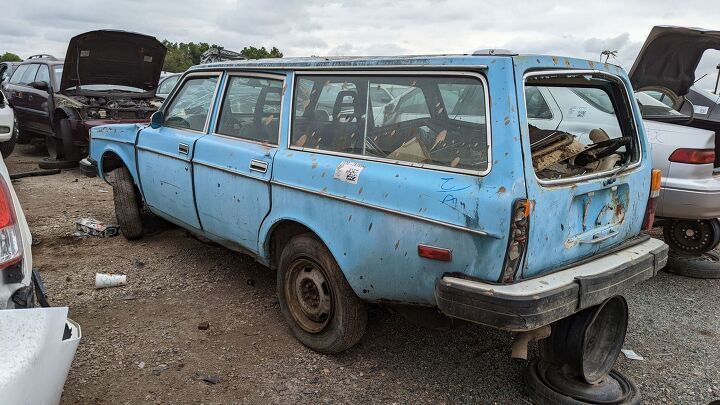Volvo began selling its now-legendary brick-shaped sedans and wagons here in the 1968 model year, with the 140, and continued with the rear-driven sensible square Swedes all the way through the 1998 S90/ V90. Of all those cars, though, the most iconic is the 240. The first of the 240s showed up in North America for the 1975 model year, and here's one of them: a 245 DL wagon in a Denver self-service boneyard last summer.

Though Volvo kept building supposed replacements for the 200 Series (which also included six-cylinder cars and weirdly chopped Italianate coupes), the 240 stayed in production all the way through 1993.

I found registration documents indicating that this car last saw road action in the middle 1990s. It's packed full of decades of old Volvo parts and general rubbish, so I think it got picked up by a Volvo collector as a parts car and then ended up serving as an outdoor storage shed.

Volvo and Mercedes-Benz were the only companies selling cars with six-digit odometers in North America at this time (that I know about), so we can see that this 245 racked up a respectable mile total during its 20 or so years of driving. I just found a junked 1990 244 with 631,999 miles; these cars benefit from the combination of good build quality and fanatically devoted owners.

The original manuals were still in it, under layers of grimy-parts-filled Coors boxes and mouse poop.

I had to buy this owner's manual for my collection, and inside I found the name and address of the original owner. Today's Junkyard Find started its career in Tampa, Florida, then (as I learned from other papers in the mess) migrated to Colorado in the middle 1980s.

If I'm reading the build tag correctly, this car was built in Canada, at the Volvo Halifax Assembly plant in Nova Scotia. That gives it an interesting Västra Götaland/Nova Scotia/Florida/Colorado life story.

In 1975, North American Volvos were designated using the system in which the first digit represented the car series, the second the number of engine cylinders, and the third the number of doors. After that came the trim level. Starting in 1980, all these cars were badged as 240s here (except for a handful of 260s), but most Volvo fanciers stick with the original system today.

This car is a base-grade DL with automatic transmission, so its MSRP was 6,095 Florida dollars (that comes to about 34,720 Florida dollars after inflation).

The rear wiper and demist features were standard equipment, but the air conditioning would have added $362.50 ($2,065 in 2022 dollars) to the cost.

The engine would have been a 2.0-liter pushrod Red Block four-cylinder, rated at 98 horsepower, but it's gone. My guess is that this car was bought by its final owner as an engine donor, though it's possible that some PV544 or Amazon owner wanted a genuine OHV engine for a project and bought it from this junkyard. Volvo went to overhead-cam engines for US-market cars starting in the 1976 model year.

Most early 240s that I find in junkyards have manual transmissions, but this one has the optional Borg-Warner three-speed slushbox. With a curb weight of around 3,000 pounds, this car would have been fairly slow but not intolerable with 98 horses and an automatic.

There's plenty of body damage, but I can't tell if it happened on the street or in a field full of parts-stuffed dead Volvos.

The ancient, misshapen tires speak of decades of sitting in one spot.

Here are the instructions for using the "wayback" seat, in Swedish, English, German, and French.

These early VDO quartz clocks usually work, but I already have one of this type and so I didn't buy the one in this car.

It's not rusty, but it's still a torn-up hooptie that wouldn't have been worth fixing up. No, that's not the actual license plate number.

This car spent more years fading away in a field than it did on the road, which seems sad.

There are still some good parts here and there, so a few of them will live on in other Volvos. I grabbed a couple of the dash switches, for use in future junkyard-parts boomboxes.

Next stop: The Crusher.

"It's no surprise that a car this carefully thought out should appeal to people who think. 87 percent of all Volvo buyers are college-educated. The other 13 percent are just plain smart."

The headlights and hood changed a bit over the years, but otherwise, it's tough to tell a 1975 245 from a 1982 245 from a 1993 245.
For links to more than 2,300 additional Junkyard Finds, please visit the Junkyard Home of the Murilee Martin Lifestyle Brand™.
[Images by the author]
Become a TTAC insider. Get the latest news, features, TTAC takes, and everything else that gets to the truth about cars first by subscribing to our newsletter.
via Autobuzz Today
Comments
Post a Comment